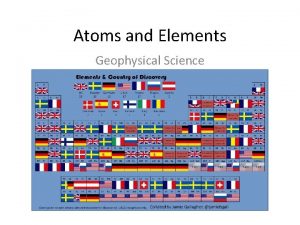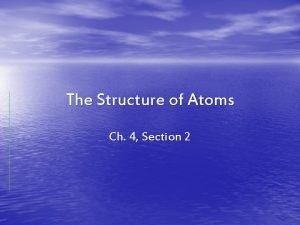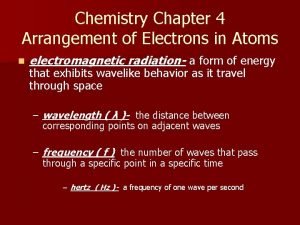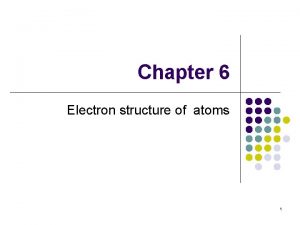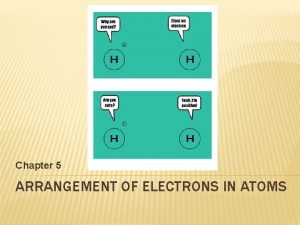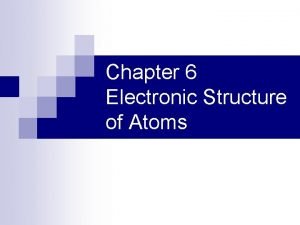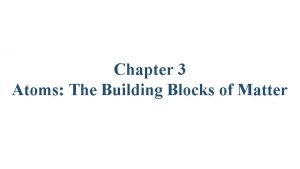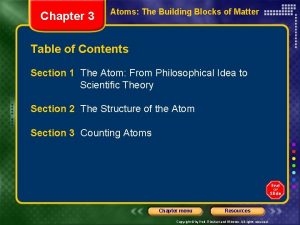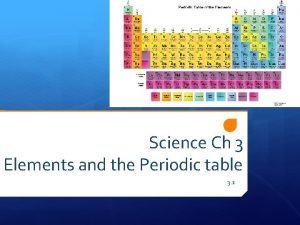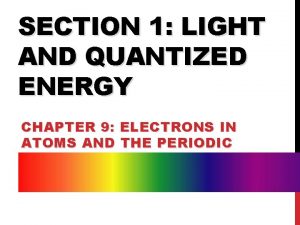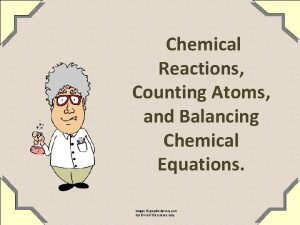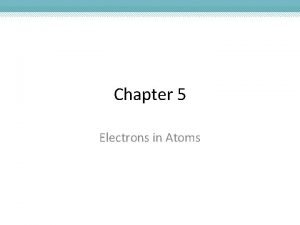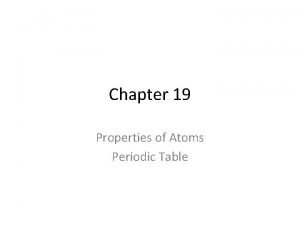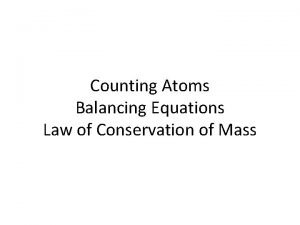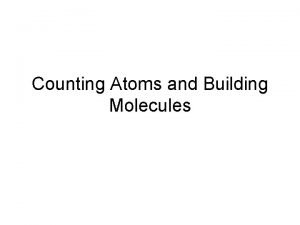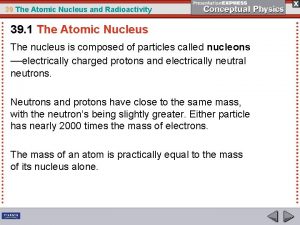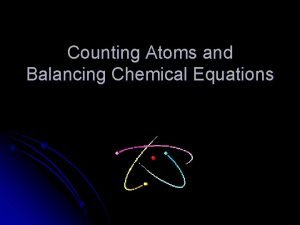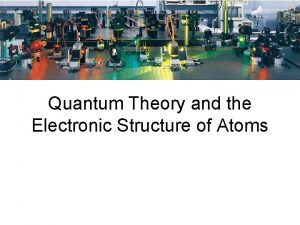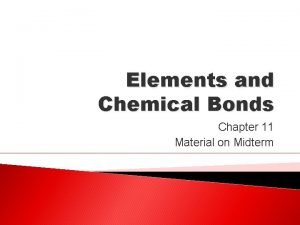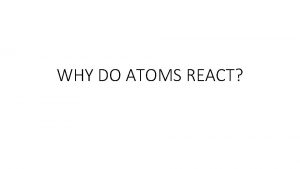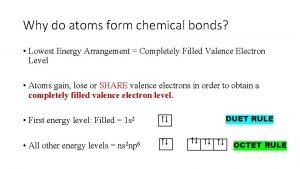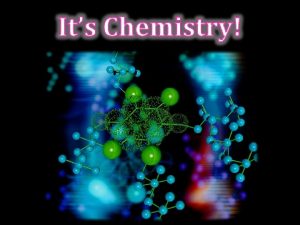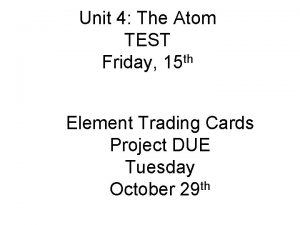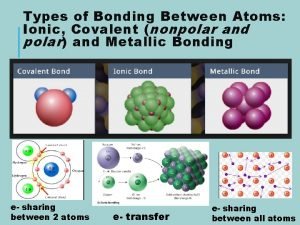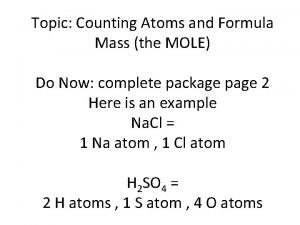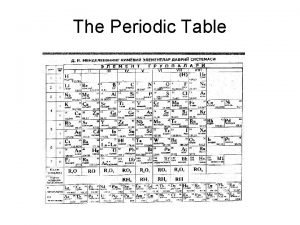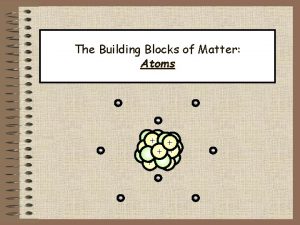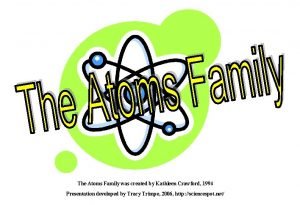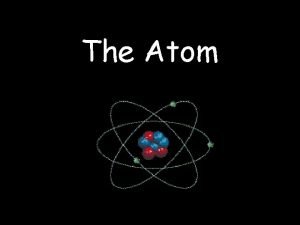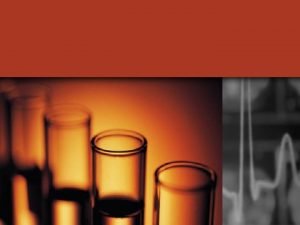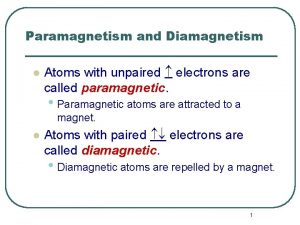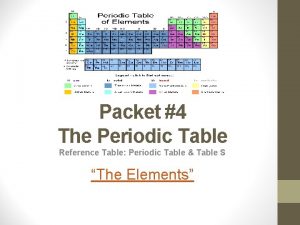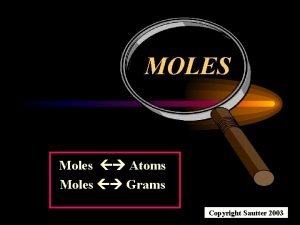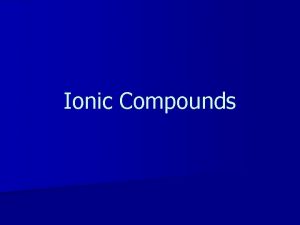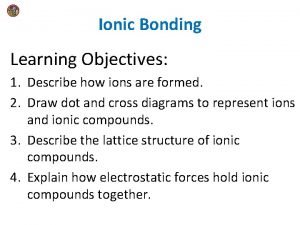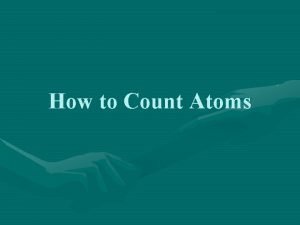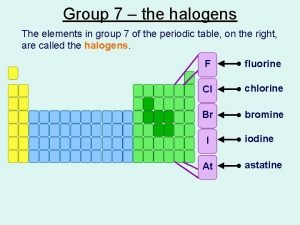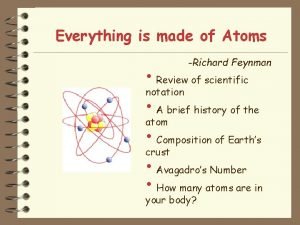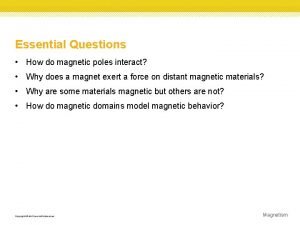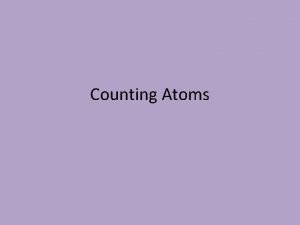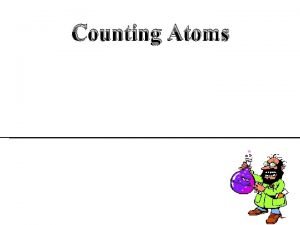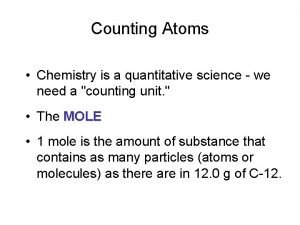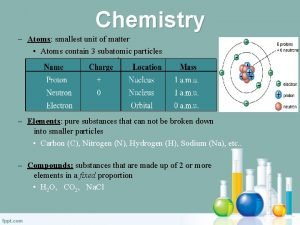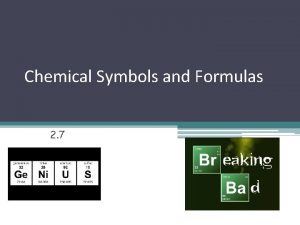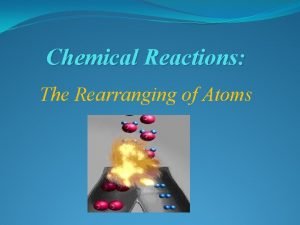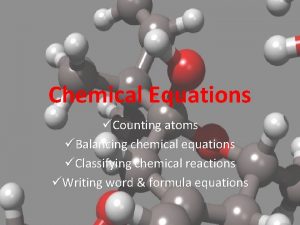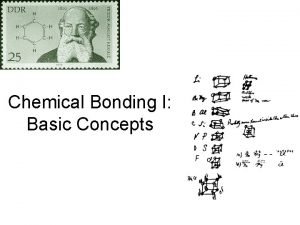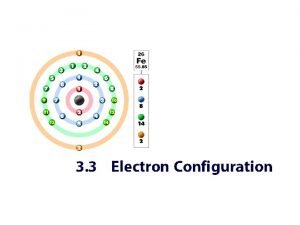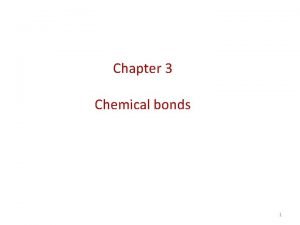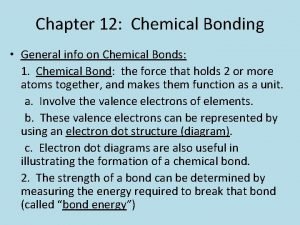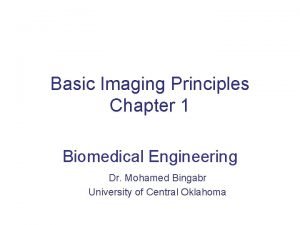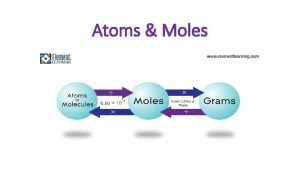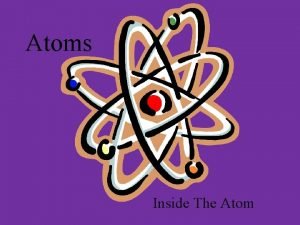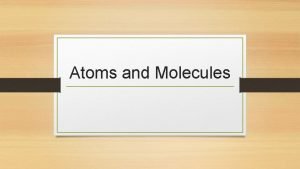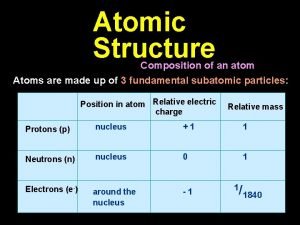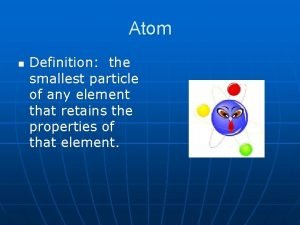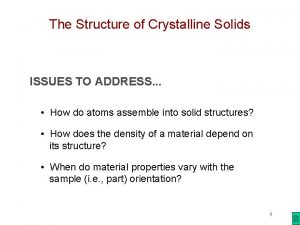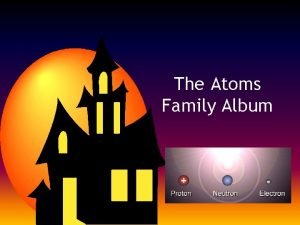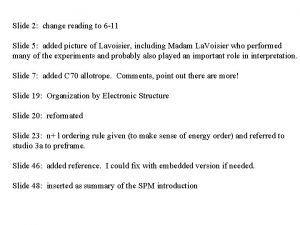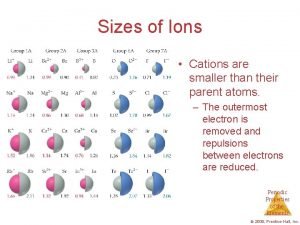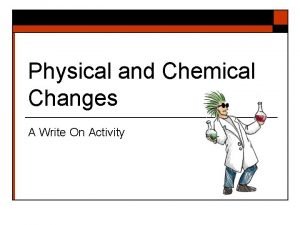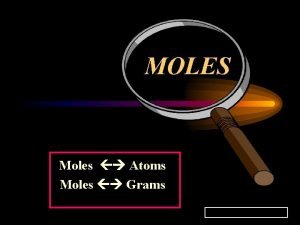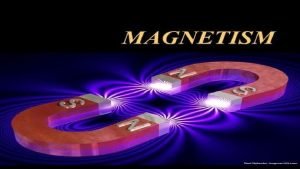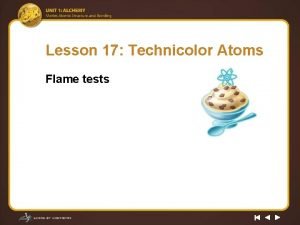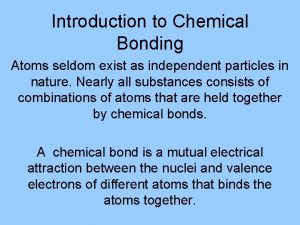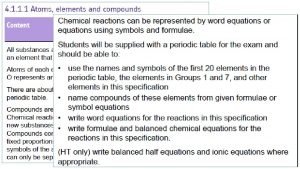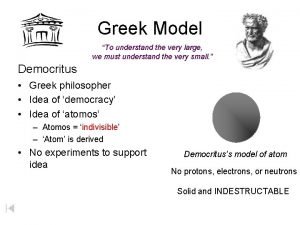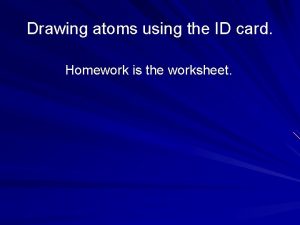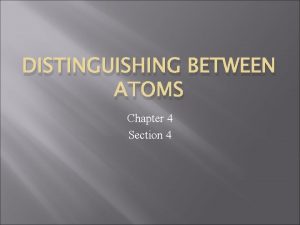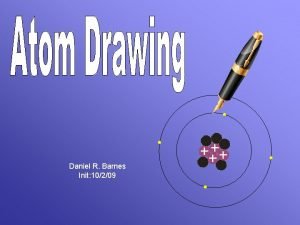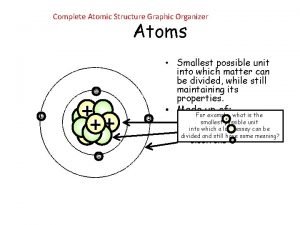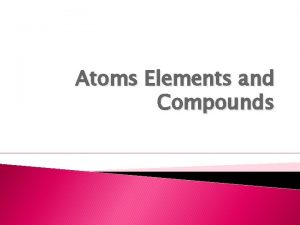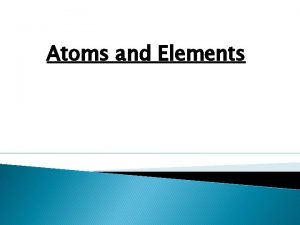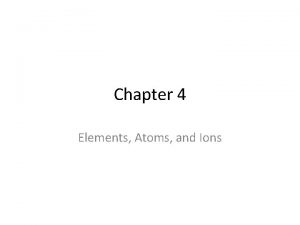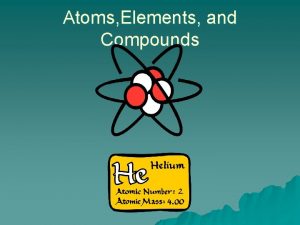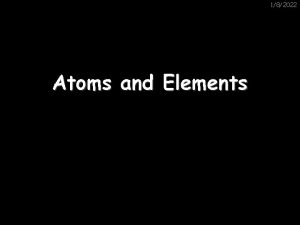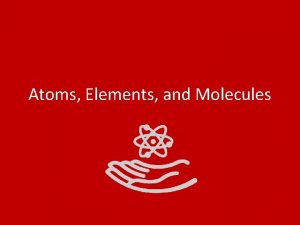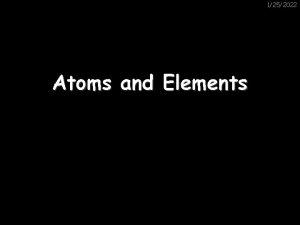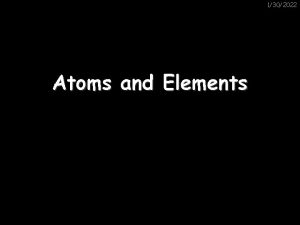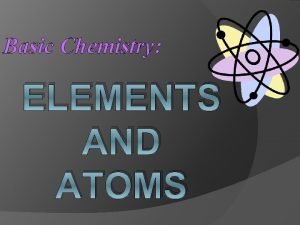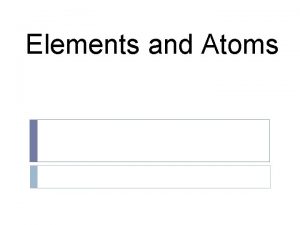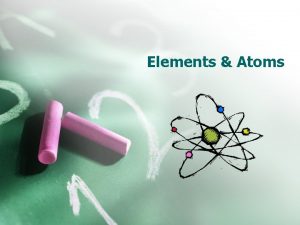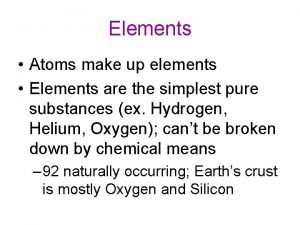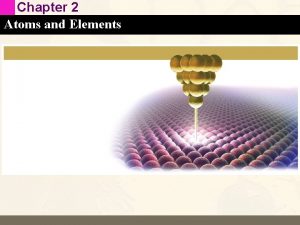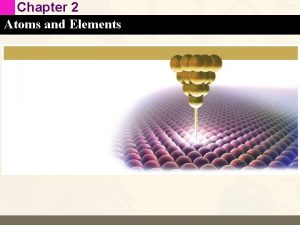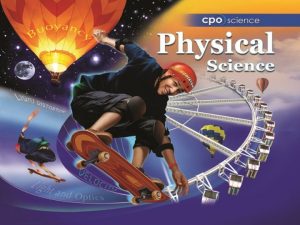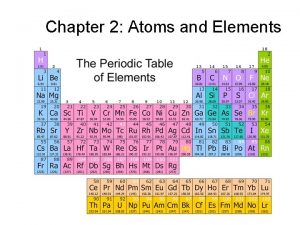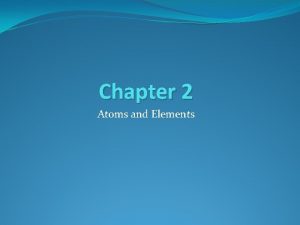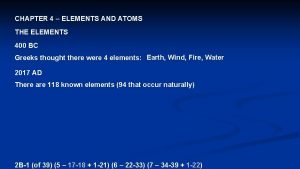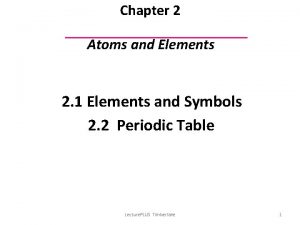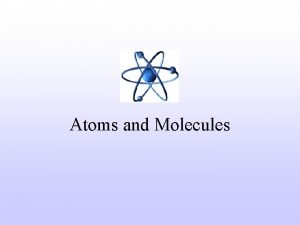Chapter 2 Atoms and Elements Chapter 2 Atoms
















































































































- Slides: 112

Chapter 2 Atoms and Elements

Chapter 2 Atoms and Elements 2. 1 2. 2 2. 3 2. 4 2. 5 2. 6 2. 7 2. 8 2. 9 Imaging and Moving Individual Molecules Early Ideas about the building blocks of Matter Modern Atomic theory and the Laws that led to it The Discovery of the Electron The Structure of the Atom Subatomic Particles: Protons, Neutrons and Electrons in Atoms Finding Patterns: The Periodic Law and the Periodic Table Atomic Mass: The Average Mass of an Element’s Atoms Molar Mass: Counting Atoms by Weighing Them 2

Section 2. 1 Imaging and Moving Individual Atoms Atomos - indivisible • An atom of carbon is the smallest unit that we can divide graphite into and still call it carbon. • Is an atom of carbon truly indivisible? • Scale of the Universe 3

Section 2. 3 Modern Atomic Theory and the Laws that Led to It Three Laws • Modern Atomic Theory – All matter is composed of atoms • Offers an explanation for observations and laws • The Three Most Influential – – – The Law of Conservation of Mass The Law of Definite Proportions The Law of Multiple Proportions 4

Section 2. 3 Modern Atomic Theory and the Laws that Led to It The Law of Conservation of Mass • In a chemical reaction, matter is neither created nor destroyed – This is a Law because it describes what happens not why (theory or model) • The particles of matter rearrange , the amount of matter is conserved • This was Lavoisier (Chapter 1) 5

Section 2. 3 Modern Atomic Theory and the Laws that Led to It Conceptual Connection • When a log burns up in a fire the mass of the ash is much less than the mass of the log. What happened the extra mass? 6

Section 2. 3 Modern Atomic Theory and the Laws that Led to It The Law of Definite Proportions • Joseph Proust • Studied the composition of compounds vs mixtures and noticed that: • Elements in a compound always present in fixed (definite) proportions • Elements in a mixture can be present in any proportions 7

Section 2. 3 Modern Atomic Theory and the Laws that Led to It The Law of Definite Proportions • All samples of a given compound, regardless of their source or how they were prepared, have the same proportion of their constituent elements. • Basically what he is saying is that water is always H 2 O never H 3 O or HO 2. • This seems obvious to us – but back in the early days of chemistry they were just figuring this stuff out. 8

Section 2. 3 Modern Atomic Theory and the Laws that Led to It The Law of Multiple Proportions • Law of definite proportions got another scientist (John Dalton) thinking. • Dalton reasoned when atoms combined into compounds they would combine as whole units 9

Section 2. 3 Modern Atomic Theory and the Laws that Led to It The Law of Multiple Proportions • If A reacts with B to form more than one kind of compound then you will get combinations like this • AB, AB 2, AB 3, A 2 B, A 3 B etc • Oxygen reacts with nitrogen to form • NO and NO 2 and N 2 O 10

Section 2. 3 Modern Atomic Theory and the Laws that Led to It The Law of Multiple Proportions • Lets say we have 1 g of carbon that we react with oxygen • We end up with two different compounds – One contains 2. 67 g of oxygen – One contains 1. 33 g of oxygen 11

Section 2. 3 Modern Atomic Theory and the Laws that Led to It The Law of Multiple Proportions • Does not seem that helpful until you take the ratio of the oxygen 2. 67/1. 33 = 2 – One compound has twice as much oxygen as the other – Of course we know that the two compounds are CO 2 and CO. 12

Section 2. 3 Modern Atomic Theory and the Laws that Led to It The Law of Multiple Proportions • When two elements (call them A and B) form two different compounds, the masses of element B that combine with 1 g of element A can be expressed as a ratio of whole numbers. 13

Section 2. 3 Modern Atomic Theory and the Laws that Led to It Example • The following data were collected for several compounds of nitrogen and oxygen. How do these data illustrate the law of multiple proportions? Mass of Nitrogen That Combines with 1 g of Oxygen Compound A 1. 750 g Compound B 0. 8750 g Compound C 0. 4375 g 14

Section 2. 3 Modern Atomic Theory and the Laws that Led to It Example • For the law of multiple proportions to hold, the ratios of the masses of nitrogen combining with 1 gram of oxygen in each pair of compounds should be small whole numbers. Mass of Nitrogen That Combines with 1 g of Oxygen Compound A 1. 750 g Compound B 0. 8750 g Compound C 0. 4375 g A/B = 1. 750/0. 8750 = 2/1 B/C = 0. 8750/0. 4375 = 2/1 A/C = 1. 750/0. 4375 = 4/1 15

Section 2. 3 Modern Atomic Theory and the Laws that Led to It Definite vs Multiple Proportions • The Law of definite proportion states that in two or more samples of the same compound the ratio of one element to the other is always the same. Carbon dioxide always CO 2 and carbon monoxide always CO • The Law of multiple proportion states that carbon and oxygen can combine in more than one way (CO and CO 2). 16

Section 2. 3 Modern Atomic Theory and the Laws that Led to It John Dalton and the Atomic Theory • We have been talking about Laws – Descriptions of “What Happens” • John Dalton brought together the best thinking and ideas of lots of other scientists and published a theory (or model) – Attempt to explain “Why” – John Dalton - Atomic Theory 17

Section 2. 3 Modern Atomic Theory and the Laws that Led to It Dalton’s Atomic Theory 1. 2. 3. 4. Each element is made up of tiny indestructible particles called atoms. All atoms of a given element have the same mass and other properties that distinguish them from atoms of other elements Atoms combine in simple whole number ratios to form compounds. Atoms of one element cannot change into atoms of another element. In a chemical reaction, atoms only change the way that they are bound together with other atoms. 18

Section 2. 4 The Discovery of the Electron Scientists can’t leave well enough alone • • So now we have the Atomic Theory All matter is composed of atoms Atoms are indivisible So, of course, scientists immediately went about trying to figure out what atoms were made of 19

Section 2. 4 The Discovery of the Electron Cathode Rays • Electricity is the hot new tool in science • JJ Thomson • Ran a current of electricity between two electrodes at either end of a partially evacuated tube (cathode tube) • Noticed a beam of particles travelling from the cathode (negative electrode) to the anode (positive electrode) • He named them “cathode rays” 20

Section 2. 4 The Discovery of the Electron Cathode Rays Fig 2. 3 J J Thomson - The Discovery of the Electron J J Thomson’s Cathode Ray tube 21

Section 2. 4 The Discovery of the Electron Cathode Rays • Stream of charged particles emitted from a electrically charged metal plate – Travel in a straight line – Independent of material used for cathode – Repelled by negative pole of applied electrical field 22

Section 2. 4 The Discovery of the Electron Cathode Rays • Thomson calculated the charge-to-mass ratio 23

Section 2. 4 The Discovery of the Electron The Electron • Thomson had discovered the electron • Negatively charged, low mass particle within all atoms. • So it turns out the atom is not indivisible after all 24

Section 2. 4 The Discovery of the Electron The Electron • Atom is not indivisible • This opened up the field of “subatomic structure” • Also asked new questions – What are the characteristics of this new “subatomic” particle? – What is the structure of the atom itself? • Lets look at how they tried to figure these out 25

Section 2. 4 The Discovery of the Electron Millikan’s Oil Droplet Experiment and the Charge of Electrons • Used electricity • Radioactivity • Charged up oil droplets • Suspended them in an electric field • Millikan oil drop experiment • Video 26

Section 2. 4 The Discovery of the Electron Millikan’s Oil Droplet Experiment and the Charge of Electrons • Suspend the fall of the droplets by adjusting the voltage across two plates. 27

Section 2. 4 The Discovery of the Electron Millikan’s Oil Droplet Experiment and the Charge of Electrons • Charge on the oil drop is a multiple of 1. 60217646 × 10 – 19 coulombs • This is the charge on a single electron 28

Section 2. 4 The Discovery of the Electron Millikan’s Oil Droplet Experiment and the Charge of Electrons • Who cares about the chage of an electron? • 2 reasons – 1. Now that we are dividing atoms up into subatomic particles it is helpful and informative to know the characteristics of these particles. – 2. We can use the charge of the electron to determine its mass. 29

Section 2. 4 The Discovery of the Electron Millikan’s Oil Droplet Experiment and the Charge of Electrons • Using the charge of an electron to determine the mass. • Well we already have the charge/mass ratio. – Thomson figured this out with the Cathode rays • So if we figure out the charge then we can calculate the mass of a subatomic particle. 30

Section 2. 4 The Discovery of the Electron Millikan’s Oil Droplet Experiment and the Charge of Electrons • Since he knew the ratio of charge to mass he was able use the charge of an electron to determine its mass. • Mass of the electron is 9. 10 x 10 – 28 g 31

Section 2. 5 The Structure of the Atom Models of the Structure of the Atom • If atoms contain negative charges (electrons) they must also contain some type of positive charge. • The question thomson wanted to answer was how these positive and negative charges arranged. What is the internal structure of the atom? 32

Section 2. 5 The Structure of the Atom JJ Thomson (Plum Pudding Model) • Reasoned that the atom might be thought of as a uniform “pudding” of positive charge with enough negative electrons scattered within to counterbalance that positive charge. 33

Section 2. 5 The Structure of the Atom Ernest Rutherford (1911) • • Graduate student of J. J. Thompson Father of nuclear physics Wanted to test the plum pudding model of atomic structure New “big thing” in science is radioactivity Enrnest Rutherford – Wiki. Quote All science is either physics or stamp collecting. 34

Section 2. 5 The Structure of the Atom Gold Foil Experiment • Ernest Rutherford – Shoot large, positive particles (a particles) • Product of radioactive decay – At a thin gold foil – Observe how particles are deflected 35

Section 2. 5 The Structure of the Atom Fig 2. 6 Source = Piece of uranium Fig. 4 -5, p. 84 36

Section 2. 5 The Structure of the Atom Gold Foil Experiment • • If Plum pudding model correct most a particles would fly right through barely deflected Not what they saw − − • Most particles went right through A few bounced off at weird angles – like they were hitting something “Almost as if you had fired a 15 inch shell at a piece of tissue paper and it came back and hit you” 37

Section 2. 5 The Structure of the Atom Gold Foil Experiment • • How to explain these results Rutherford reasoned that most of the mass of the atom must be concentrated in a relatively small area 38

Section 2. 5 The Structure of the Atom Fig. 4 -6, p. 84 39

Section 2. 5 The Structure of the Atom Nuclear Theory of the Atom 1. Most of the atom’s mass and all of its positive charge are contained in a small core called the nucleus. 2. Most of the volume of the atom is empty space, throughout which tiny, negatively charged particles are dispersed. 3. There as many negatively charged particles outside the nucleus as there are positively charged particles (named protons) within the nucleus, so the atom is electrically neutral. 40

Section 2. 5 The Structure of the Atom Discovery of the Neutron • • OK so we have a model of the atom. But we still have some problems Hydrogen atom has 1 proton and Helium atom has 2 yet Helium weighs 4 times as much as Hydrogen Rutherford and his student (Chadwick) went to work on this one 41

Section 2. 5 The Structure of the Atom Discovery of the Neutron • • • Turns out most nuclei also contain a neutral particle called the neutron. A neutron is similar in mass to a proton but has no charge. Hydrogen has no neutrons and Helium has 2 Hydrogen – 1 proton 0 neutrons Helium – 2 protons 2 neutrons 42

Section 2. 6 Subatomic Particles: Protons, Neutrons and Electrons in Atoms Subatomic Particles • The atom contains: • Protons – found in the nucleus; positive charge equal in magnitude to the electron’s negative charge. • Neutrons – found in the nucleus; no charge; virtually same mass as a proton. • Electrons – found outside the nucleus; negatively charged. 43

Section 2. 6 Subatomic Particles: Protons, Neutrons and Electrons in Atoms Nuclear Atom Viewed in Cross Section • The nucleus is: • Extremely Small compared with the overall size of the atom. − Pea at the center of Qwest field • Extremely dense; accounts for almost all of the atom’s mass. 44

Section 2. 6 Subatomic Particles: Protons, Neutrons and Electrons in Atoms

Section 2. 6 Subatomic Particles: Protons, Neutrons and Electrons in Atoms • The atom contains: What do you need to know from this table Relative charges +1, 0, – 1 Relative masses protons and neutrons appx 1 amu and electrons appx 1/2000 amu 46

Section 2. 6 Subatomic Particles: Protons, Neutrons and Electrons in Atoms Elements: Defined by Their Number of Protons • If all atoms are composed of the same subatomic particles then how can atoms can be different from each other. • What makes a carbon atom as distinct from a sodium atom or a copper atom? • The number of particles • More specifically, the number of protons. 47

Section 2. 6 Subatomic Particles: Protons, Neutrons and Electrons in Atoms Elements: Defined by Their Number of Protons • The number of protons in an atom is called the atomic number – Carbon has 6 protons – atomic number = 6 – Sodium has 11 protons – atomic number = 11 – Copper has 29 protons – atomic number = 29 • Identity of an element arises from number of protons. 48

Section 2. 6 Subatomic Particles: Protons, Neutrons and Electrons in Atoms Elements: Defined by Their Number of Protons • So far 118 elements have been discovered or synthesized • Periodic Table By Sandbh - Own work, CC BY-SA 4. 0, https: //commons. wikimedia. org/w/index. php? curid=45579529 49

Section 2. 6 Subatomic Particles: Protons, Neutrons and Electrons in Atoms Elements: Defined by Their Number of Protons • Each element has – Unique atomic number – Unique chemical symbol • Some of these are based on the English names – H for Hydrogen He for Helium • Others are based on the Latin names – Na for sodium (from the Latin natrium) – atomic number 11 – Sn for tin (from the Latin stannum) – atomic number 50 50

Section 2. 6 Subatomic Particles: Protons, Neutrons and Electrons in Atoms Isotopes: When the Number of Neutrons Varies • Turns out all atoms are not exactly the same • Isotopes are atoms with the same number of protons but different numbers of neutrons 51

Section 2. 6 Subatomic Particles: Protons, Neutrons and Electrons in Atoms Isotopes: When the Number of Neutrons Varies • • • 2 isotopes of sodium. Both have 11 protons 12 vs 13 neutrons Show almost identical chemical properties In nature most elements contain mixtures of isotopes. Where do isotopes come from? How are they formed? 52

53

Section 2. 6 Subatomic Particles: Protons, Neutrons and Electrons in Atoms Isotopic Notation • • To specify isotopes we use symbolic notation X = the symbol of the element Z = the atomic number (# of protons) A = the mass number (# of protons and neutrons) 54

Section 2. 6 Subatomic Particles: Protons, Neutrons and Electrons in Atoms Isotopes – An Example • • C = the symbol for carbon 6 = the atomic number (6 protons) 14 = the mass number (6 protons and 8 neutrons) C - 14 • C = the symbol for carbon • 6 = the atomic number (6 protons) • 12 = the mass number (6 protons and 6 neutrons) • C - 12 55

Section 2. 6 Subatomic Particles: Protons, Neutrons and Electrons in Atoms Concept Check Write the symbolic notation for these two isotopes of sodium. 56

Section 2. 6 Subatomic Particles: Protons, Neutrons and Electrons in Atoms Learning Check A certain isotope X contains 54 electrons and 78 neutrons. • What is the mass number of this isotope? 57

Section 2. 6 Subatomic Particles: Protons, Neutrons and Electrons in Atoms Ions: Losing and Gaining Electrons • In a neutral atoms the number of protons is equal to the number of electrons – Negative charge = positive charge 58

Section 2. 6 Subatomic Particles: Protons, Neutrons and Electrons in Atoms Concept Check • How many protons and electrons in a neutral atom of • Lithium (Li) • Bromine (Br) 59

Section 2. 6 Subatomic Particles: Protons, Neutrons and Electrons in Atoms Ions: Losing and Gaining Electrons • During chemical changes atoms can gain or lose electrons to become ions (charged atom) • Metals tend to lose electrons to become positively charged cations – Li Li+ + 1 e – • Nonmetals tend to gain electrons to become negatively charged anions – Br + 1 e – Br – 60

Section 2. 6 Subatomic Particles: Protons, Neutrons and Electrons in Atoms Concept Check • How many protons and electrons in the lithium and bromine ions • Lithium cation (Li+) • Bromine anion (Br –) 61

Section 2. 7 Finding Patterns: The Periodic Law and the Periodic Table The Periodic Table 62

Section 2. 7 Finding Patterns: The Periodic Law and the Periodic Table Mendeleev • Elements were discovered and purified one at a time • Late 1800 s scientists started to group chemicals together that all behaved the same way • 1872, Dmitri Mendeleev arranged the 60 know elements into groups with similar properties and arranged them in order of increasing atomic mass 63

Section 2. 7 Finding Patterns: The Periodic Law and the Periodic Table from Mendeleev’s 1869 paper http: //www. aip. org/history/curie/periodic. htm 64

Section 2. 7 Finding Patterns: The Periodic Law and the Periodic Table Superimpose on Modern Periodic Table http: //www. msnucleus. org/membership/html/jh/physical/periodictable/lesson 5/periodic 5 b. html 65

Section 2. 7 Finding Patterns: The Periodic Law and the Periodic Table Predictive Power of Mendeleev’s Table • There are bunch of gaps in Mendeleev’s first version of the periodic table • This is because lots of elements had not been discovered or characterized yet. • His table was revolutionary and ingenious because it actually predicted the properties of elements that had not been discovered yet! • The Genius of Mendeleev 66

Section 2. 7 Finding Patterns: The Periodic Law and the Periodic Table The Periodic Law • When the elements are arranged in order of increasing mass, certain sets of properties recur periodically Fig. 2. 10 67

Section 2. 7 Finding Patterns: The Periodic Law and the Periodic Table Periodic Law and Quantum Mechanical Theory • The Periodic Law was something that was observed – Properties of elements repeat in a periodic way – It is a law because it describes what happens but does not attempt to explain why • About 50 years later theory of Quantum Mechanics was presented that explains why the periodic behavior exists. (Ch 7 and 8) 68

Section 2. 7 Finding Patterns: The Periodic Law and the Periodic Table Representative Elements 1 A – 8 A Transition Elements 1 B – 8 B Second numbering system 1 – 18 We will use the 1 – 8 A and B You are responsible for the names and symbols of the elements Listed (in pink) on the elements PDFs in the handouts module. 69

Section 2. 7 Finding Patterns: The Periodic Law and the Periodic Table Groups and Periods On the periodic table, • elements are arranged according to similar properties • groups contain elements with similar properties in vertical columns • periods are horizontal rows of elements 70

Section 2. 7 Finding Patterns: The Periodic Law and the Periodic Table Groups and Periods 71

Section 2. 7 Finding Patterns: The Periodic Law and the Periodic Table Classification of Groups 72

Section 2. 7 Finding Patterns: The Periodic Law and the Periodic Table Groups with Specific Names • Alkali Metals (1 A) Brainiac • Very reactive metals, explode in water, very soft • Alkaline Earth Metals (2 A) – Less reactive than alkali metals, less soft, found in higher concentrations in rocks and soil • Halogens (7 A) – Reactive nonmetals, most are gases at room temperature • Noble Gases (8 A) – Non reactive gases 73

Section 2. 7 Finding Patterns: The Periodic Law and the Periodic Table Metals, Nonmetals, and Metalloids • The heavy zigzag line separates metals and nonmetals. • Metals are located to the left. • Nonmetals are located to the right. * • Metalloids are located along the heavy zigzag line between the metals and nonmetals. − Aluminum and Polonium are exceptions • * notice there is one lonely nonmetal on the left side of the table 74

Section 2. 7 Finding Patterns: The Periodic Law and the Periodic Table Metals, Nonmetals, and Metalloids 75

Section 2. 7 Finding Patterns: The Periodic Law and the Periodic Table Properties of Metals, Nonmetals, and Metalloids Metals (most elements) • Are shiny and ductile (can be pulled into wires) and malleable (can be hammered into sheets) • Are good conductors of heat and electricity • Most are solid at room temperature. Which isn’t? Nonmetals • Are dull, brittle, and poor conductors • Are good insulators • Solids, liquids or gases and room temperature Metalloids • Are better conductors than nonmetals, but not as good as metals • Are used as semiconductors and insulators 76

Section 2. 7 Finding Patterns: The Periodic Law and the Periodic Table 7 Elements Exist as Diatomic Molecules in their Elemental Forms 77

Section 2. 7 Finding Patterns: The Periodic Law and the Periodic Table Allotropes • • Different forms of a given element. Example: Solid carbon occurs in three forms. • Diamond • Graphite • Buckminsterfullerene 78

Section 2. 7 Finding Patterns: The Periodic Law and the Periodic Table Ions and The Periodic Table • Metals tend to lose electrons in chemical reaction – Li Li+ + 1 e – Lithium cation • Nonmetals tend to gain electrons in chemical reactions – Br + 1 e – Br – Bromine anion • In both of these examples only one electron is gained or lost but this is not always the case, sometimes 2 or even 3 79

Section 2. 7 Finding Patterns: The Periodic Law and the Periodic Table How to Predict the Charges of Ions • Groups 1, 2 and 3 lose 1, 2 and 3 – Metals lose electrons • Groups 5 – 7 gain 8 minus (group number) – Nonmetals gain electrons 80

Section 2. 7 Finding Patterns: The Periodic Law and the Periodic Table Learning Check Predict the charges of ions formed by the following: A. Sr B. Se C. Cs 81

Section 2. 8 Atomic Mass: The Average Mass of an Elements Atomic Mass • Dalton thought that all atoms of the same element had exactly the same mass – – • • Not strictly true Isotopes have slightly different masses We can calculate an average mass of the atoms of an element This is called the Atomic Mass – Average mass of the isotopes of an element weighted according to their abundance. 82

Section 2. 8 Atomic Mass: The Average Mass of an Elements Atomic Mass for Carbon • • When we look at the periodic table, the atomic mass for carbon is not 12. It is 12. 01. That is because carbon naturally exists as a mixture of isotopes. The mass of carbon is an average of the masses of the different isotopes. 12 C, 13 C and 14 C – – All have 6 protons – that is what makes them carbon Have 6, 7 and 8 neutrons – that is what makes them isotopes 83

Section 2. 8 Atomic Mass: The Average Mass of an Elements Atomic Mass for Carbon • 98. 89% of 12 C and 1. 11% of 13 C – (14 C is negligible) • 98. 89% of 12 amu + 1. 11% of 13. 0034 amu = • (0. 9889)(12 amu) + (0. 0111)(13. 0034 amu) = • 12. 01 amu 84

Section 2. 8 Atomic Mass: The Average Mass of an Elements Atoms Learning Check An element consists of 62. 60% of an isotope with mass 186. 956 amu and 37. 40% of an isotope with mass 184. 953 amu. • Calculate the average atomic mass and identify the element. 85

Section 2. 8 Atomic Mass: The Average Mass of an Elements Atomic Mass Unit • • • It doesn’t make sense to refer to the mass of an atom in grams – atoms are really small So chemists defined the Atomic Mass Unit Originally corresponded the mass of 1 H – • • Makes sense – smallest atom Then for a while is was 1/16 the atomic weight of a single atom of oxygen Both of these roughly corresponded to a nucleon (particle that makes up the nucleus) – Either a proton of neutron 86

Section 2. 8 Atomic Mass: The Average Mass of an Elements Atomic Mass Unit • • Current definition of an atomic mass unit One atom of 12 C is assigned the mass of exactly 12 atomic mass units So 1 amu = 1/12 the mass of an atom of 12 C Masses of all other atoms are assigned relative to this standard. 87

Section 2. 8 Atomic Mass: The Average Mass of an Elements Atoms Average Atomic Mass for Carbon • • Even though natural carbon does not contain a single atom with mass 12. 01, for stoichiometric purposes, we can consider carbon to be composed of only one type of atom with an average mass of 12. 01 amu. This enables us to count atoms of natural carbon by weighing a sample of carbon. 88

Section 2. 8 Atomic Mass: The Average Mass of an Elements Atoms Mass Spectrometry • • • So 1 amu = 1/12 the mass of an atom of 12 C Masses of all other atoms are assigned relative to this standard. Most accurate method to determine atomic mass is mass spectrometry. 89

Section 2. 8 Atomic Mass: The Average Mass of an Elements Atoms Mass Spectrometry 1) 2) 3) 4) Vaporize sample Ionize sample – create positive ions Electric field accelerates particles Ions are deflected in magnetic field 90

Section 2. 8 Atomic Mass: The Average Mass of an Elements Atoms Mass Spectrometry • How does deflection of ions help us determine atomic mass? – Large ions deflected the least and small ions deflected the most – Amount of defection is an indication of relative size – To get a measure of absolute size the samples are always compared to a standard that is mixed into the sample http: //www. rug. nl/research/isotope-research/projects/radiocarbonams? lang=en 91

Section 2. 8 Atomic Mass: The Average Mass of an Elements Atoms Mass Spectrometry • • When 12 C and 13 C are analyzed 13 C is deflected slightly less (more massive) The degree of deflection of ions if translated into a ratio of masses 92

Section 2. 8 Atomic Mass: The Average Mass of an Elements Atoms Mass Spectrometry How does deflection of ions help us determine the abundance of two isotopes? 1. Fig 2. 17 The position of each peak indicates the atomic mass The intensity of the peak indicates the relative abundance of the two isotopes 2. • Each peak is a percentage of the total intensity 93

Section 2. 9 Molar Mass: Counting Atoms by Weighing Them Counting by Weighing • • When we count by weighing we use the average mass of an individual object in a sample The average mass of the object allows us to behave as though they were all identical. 94

Section 2. 9 Molar Mass: Counting Atoms by Weighing Them Average Mass of an Atom • The Atomic Mass is expressed in amu – atomic mass units – Atomic mass of carbon is 12. 01 amu – Atomic mass of helium is 4. 003 amu – Atomic mass of sodium is 22. 99 amu 95

Section 2. 9 Molar Mass: Counting Atoms by Weighing Them The Mole: A Chemist’s Dozen • Samples of matter contain enormous numbers of atoms • So just like we needed a special unit for the mass of an atom (amu), we need a unit for a collection of atoms 96

Section 2. 9 Molar Mass: Counting Atoms by Weighing Them The Mole: A Chemist’s Dozen • Can’t use a dozen or a hundred • The unit we use is the Mole • The number of carbon atoms in exactly 12 grams of 12 C • This number was determined to be 6. 022 x 1023 C atoms (Again from mass spectrometry) • Avogadro’s number – After the first scientist who estimated it 97

Section 2. 9 Molar Mass: Counting Atoms by Weighing Them The Mole: A Chemist’s Dozen • A mole is both a Number of particles and a Mass • • Mole is a Number of particles A mole is a unit just like a dozen 1 dozen = 12 of something 1 mole = 6. 022 x 1023 particles • • • Mole is also a Mass A dozen eggs has a mass ~ a pound or so Mass of a mole in grams = to atomic weight in amu * * See the Proof called “The Mole” on the website 98

Section 2. 9 Molar Mass: Counting Atoms by Weighing Them The Mole: A Chemist’s Dozen • This means that a mole of any element has a mass in grams that is equal to its atomic weight in amu. • Carbon 12. 01 amu/atom 12. 01 g/mole 6. 022 x 1023 C atoms • Helium 4. 003 amu/atom 4. 003 g/mole 6. 022 x 1023 He atoms • Sodium 22. 99 amu/atom 22. 99 g/mole 6. 022 x 1023 Na atoms 99

Section 2. 9 Molar Mass: Counting Atoms by Weighing Them Problem Solving • So out of all these numbers and equations there are only two things you need to remember in order to solve problems • 6. 022 x 1023 particles/mole Avogadro’s number • Grams/mole = amu/atom From periodic table 100

Section 2. 9 Molar Mass: Counting Atoms by Weighing Them One-Mole Quantities 101

Section 2. 9 Molar Mass: Counting Atoms by Weighing Them Converting between number of Moles and Number of Atoms • How many atoms in 2. 50 moles of carbon? • How many moles in 5. 25 x 1025 atoms of Helium? 102

Section 2. 9 Molar Mass: Counting Atoms by Weighing Them Learning Check • How many atoms in 7. 50 moles of argon? • How many moles in 7. 35 x 1026 atoms of sodium? 103

Section 2. 9 Molar Mass: Counting Atoms by Weighing Them Converting between Mass and Amount (Number of Moles) • What is the mass (in grams) of 0. 535 moles of copper? • How many moles are in 1. 22 g of potassium? 104

Section 2. 9 Molar Mass: Counting Atoms by Weighing Them Learning Check • What is the mass (in grams) of 2. 88 moles of iron? • How many moles are in 25 g of calcium? 105

Section 2. 9 Molar Mass: Counting Atoms by Weighing Them Converting between Mass and Number of Atoms • How many gold atoms are in in a solid gold ring that weighs 25. 0 g • What is the mass of a sample of 2. 5 x 1027 silicon atoms 106

Section 2. 9 Molar Mass: Counting Atoms by Weighing Them Learning Check • Determine both the number of moles and the number of atoms in 25. 0 g of calcium. 107

Section 2. 9 Molar Mass: Counting Atoms by Weighing Them Learning Check • Determine the number of atoms in 5. 50 mg of lead 108

Section 2. 9 Molar Mass: Counting Atoms by Weighing Them Learning Check • Determine the number of moles and the mass of 1. 00 x 1022 atoms of silicon. 109

Section 2. 9 Molar Mass: Counting Atoms by Weighing Them Conceptual Connection • Without doing any calculations determine which sample contains the most atoms • A. 1 g of calcium 40. 08 amu • B. 1 g of nitrogen 14. 01 amu • C. 1 g of gold 196. 97 amu 110

Homework and Review • • • Links in Chapter 2 Module Review Questions Odd numbered problems Cumulative and Challenge Problems Finally – do the Sapling HW – try to do this without your notes to determine what topics you still need to review. 111

Section 2. 9 Suggested Homework • 3 rd Edition (original – orange cover) • Review Questions • Odd numbered problems 29 – 135 • 3 rd Edition (updated – green cover) • Self Assessment Quiz • Odd numbered problems 1 – 88 112
 Chapter 6 chemistry in biology
Chapter 6 chemistry in biology Chapter 6 section 1 atoms elements and compounds
Chapter 6 section 1 atoms elements and compounds Regents periodic table
Regents periodic table Atoms elements molecules and compounds worksheet
Atoms elements molecules and compounds worksheet Section 1 atoms elements and compounds
Section 1 atoms elements and compounds What is the relationship between atoms and elements
What is the relationship between atoms and elements Atoms vs elements
Atoms vs elements Www.chem.purdue/gchelp/atoms/elements.html
Www.chem.purdue/gchelp/atoms/elements.html Chapter 2 atoms molecules and ions
Chapter 2 atoms molecules and ions Elements and sub elements
Elements and sub elements Chapter 4 section 2 the structure of atoms answer key
Chapter 4 section 2 the structure of atoms answer key Arrangement of electrons in atoms chapter 4 test
Arrangement of electrons in atoms chapter 4 test Stable electron configurations are likely to contain
Stable electron configurations are likely to contain Chapter 6 electronic structure of atoms answers
Chapter 6 electronic structure of atoms answers Chapter 5 arrangement of electrons
Chapter 5 arrangement of electrons Electronic structure of atoms
Electronic structure of atoms Chapter 3 atoms the building blocks of matter
Chapter 3 atoms the building blocks of matter Chapter 3 atoms the building blocks of matter
Chapter 3 atoms the building blocks of matter Elements of drama theme
Elements of drama theme Atomic elements vs molecular elements
Atomic elements vs molecular elements Http //elements.wlonk.com/elements table.htm
Http //elements.wlonk.com/elements table.htm Folktale settings
Folktale settings What are the 3 elements of a folktale
What are the 3 elements of a folktale Electrons in atoms section 1 light and quantized energy
Electrons in atoms section 1 light and quantized energy Balancing equations counting atoms
Balancing equations counting atoms Electrons in atoms section 1 light and quantized energy
Electrons in atoms section 1 light and quantized energy Properties of atoms and the periodic table
Properties of atoms and the periodic table The lowest allowable energy state of an atom is called
The lowest allowable energy state of an atom is called Center for bits and atoms
Center for bits and atoms Electrons in atoms section 2 quantum theory and the atom
Electrons in atoms section 2 quantum theory and the atom Adding atoms
Adding atoms How can you count atoms and molecules
How can you count atoms and molecules Datación radiométrica
Datación radiométrica Counting atoms and balancing equations worksheet
Counting atoms and balancing equations worksheet Isotopes pogil
Isotopes pogil Atoms molecules and ions
Atoms molecules and ions Atoms molecules and ions
Atoms molecules and ions Atoms molecules and ions
Atoms molecules and ions Atoms molecules and ions
Atoms molecules and ions Atoms ions and molecules
Atoms ions and molecules Atoms ions and molecules
Atoms ions and molecules Quantum theory and the electronic structure of atoms
Quantum theory and the electronic structure of atoms States that atoms ions and molecules must collide to react
States that atoms ions and molecules must collide to react The two rows of elements that seem to be disconnected
The two rows of elements that seem to be disconnected Elements and their properties section 1 metals
Elements and their properties section 1 metals Chapter 11 elements and chemical bonds
Chapter 11 elements and chemical bonds C3h5 name
C3h5 name Why do atoms form chemical bonds?
Why do atoms form chemical bonds? What are atoms?
What are atoms? Kesler science crossword answer key
Kesler science crossword answer key The atoms family atomic math challenge answer key
The atoms family atomic math challenge answer key Ionic metallic and covalent bonds
Ionic metallic and covalent bonds Gfm formula
Gfm formula Atoms in increasing size
Atoms in increasing size The smallest building block of matter
The smallest building block of matter Matterville worksheet
Matterville worksheet Whats a nucleus
Whats a nucleus Atoms with 4 valence electrons
Atoms with 4 valence electrons Atoms with unpaired electrons are called diamagnetic.
Atoms with unpaired electrons are called diamagnetic. Reference table periodic table
Reference table periodic table Grans to moles
Grans to moles Define atomic mass unit
Define atomic mass unit Metallic bonding occurs between metal atoms that have
Metallic bonding occurs between metal atoms that have Atoms escape room digital locks answers
Atoms escape room digital locks answers Mri hydrogen atoms
Mri hydrogen atoms Planar density units
Planar density units What's a chemical bond
What's a chemical bond More protons than electrons
More protons than electrons How to determine number of protons
How to determine number of protons What are atoms?
What are atoms? How to count atoms
How to count atoms Group 17
Group 17 Flame test principle
Flame test principle 31536000 in scientific notation
31536000 in scientific notation How do magnetic poles interact?
How do magnetic poles interact? Atoms form
Atoms form Counting atoms practice
Counting atoms practice Counting atoms with parentheses
Counting atoms with parentheses Avogadro's number
Avogadro's number Are atoms the smallest unit of matter
Are atoms the smallest unit of matter Counting atoms worksheet answer key
Counting atoms worksheet answer key Chemical reactions rearranging atoms worksheet answers
Chemical reactions rearranging atoms worksheet answers Counting atoms
Counting atoms Non bonding electrons examples
Non bonding electrons examples Characteristic of atoms
Characteristic of atoms Why do nonmetals rarely lose electrons
Why do nonmetals rarely lose electrons Which elements have expanded octets
Which elements have expanded octets Bingabr
Bingabr Aufbau eines atoms
Aufbau eines atoms Moles of atoms
Moles of atoms Smallest atoms in periodic table
Smallest atoms in periodic table What is an atom
What is an atom Composition of an atom
Composition of an atom Atoms are small hard particles
Atoms are small hard particles Packing fraction of bcc
Packing fraction of bcc The atom family atomic math challenge
The atom family atomic math challenge Nerdy nelda neutron
Nerdy nelda neutron Seeing atoms with a microscope
Seeing atoms with a microscope Are anions smaller than their parent atoms
Are anions smaller than their parent atoms Is lighter fluid burning a physical change
Is lighter fluid burning a physical change Atoms to moles
Atoms to moles What is a clump of magnetic atoms called
What is a clump of magnetic atoms called Technicolor atoms flame test lab answers
Technicolor atoms flame test lab answers Atoms seldom exist as independent particles
Atoms seldom exist as independent particles How to do this
How to do this Greek atom model
Greek atom model Drawing atoms worksheet
Drawing atoms worksheet Distinguishing between atoms
Distinguishing between atoms Boron atom
Boron atom Struktur atom
Struktur atom Subatomic particles graphic organizer
Subatomic particles graphic organizer Unstable arrangement of atoms
Unstable arrangement of atoms Chemical bonds form when atoms *
Chemical bonds form when atoms *






